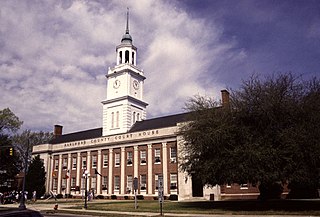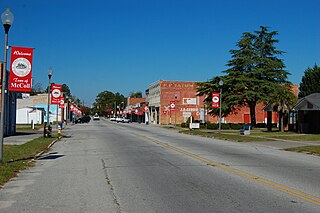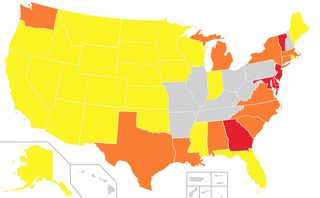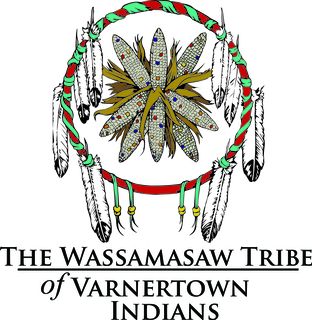
Orangeburg County is a county located in the U.S. state of South Carolina. As of the 2020 census, the population was 84,223. Its county seat is Orangeburg. The county was created in 1769.

Marlboro County is a county located in the Pee Dee region on the northern border of the U.S. state of South Carolina. As of the 2020 census, its population was 26,667. Its county seat is Bennettsville. The Great Pee Dee River runs through it. Marlboro County comprises the Bennettsville, SC Micropolitan Statistical Area.

McColl is a town in Marlboro County, South Carolina, United States. It lies in the state's Pee Dee region, 8 miles (13 km) from the North Carolina border. The population was 2,174 at the 2010 census.
The Pee Dee is a region in the northeast corner of the U.S. state of South Carolina. It lies along the lower watershed of the Pee Dee River, which was named after the Pee Dee, a Native American tribe that historically inhabited the region.
The Lumbee are a Native American people primarily centered in Robeson, Hoke, Cumberland, and Scotland counties in North Carolina. They also live in surrounding states and Baltimore, Maryland.
The Waccamaw people were an Indigenous people of the Southeastern Woodlands, who lived in villages along the Waccamaw and Pee Dee rivers in North and South Carolina in the 18th century.

The Natchez are a Native American people who originally lived in the Natchez Bluffs area in the Lower Mississippi Valley, near the present-day city of Natchez, Mississippi in the United States. They spoke a language with no known close relatives, although it may be very distantly related to the Muskogean languages of the Creek Confederacy. An early American geographer noted in his 1797 gazetteer that they were also known as the "Sun Set Indians".

State-recognized tribes in the United States are organizations that identify as Native American tribes or heritage groups that do not meet the criteria for federally recognized Indian tribes but have been recognized by a process established under assorted state government laws for varying purposes. State recognition does not dictate whether or not they are recognized as Native American tribes by continually existing tribal nations.

The Pee Dee people, also Pedee and Peedee, are American Indians of the Southeast United States. Historically, their population has been concentrated in the Piedmont of present-day South Carolina. In the 17th and 18th centuries, English colonists named the Pee Dee River and the Pee Dee region of South Carolina for the tribe.

The Wassamasaw Tribe of Varnertown Indians or Wassamasaw Tribe is a state-recognized tribe and 501(c)(3) nonprofit organization headquartered in Berkeley County, South Carolina. The organization was awarded the status of a state-recognized tribe by the South Carolina Commission of Minority Affairs in November of 2009, becoming the sixth state-recognized tribe within South Carolina. The organization is not federally recognized as a Native American tribe by the Bureau of Indian Affairs The Catawba Indian Nation is the only Tribe in South Carolina that is federally recognized by the U.S. Government.

The Chaloklowa Chickasaw Indian People or Chaloklowa Chickasaw is a 501(c)(3) nonprofit organization and "state-recognized group" not to be confused with a state-recognized tribe. The state of South Carolina gave them the state-recognized group and special interest organization designation under the SC Code Section 1-31-40 (A) (7)(10), Statutory Authority Chapter 139 (100-111) in 2005.
Waccamaw Siouan Indians are one of eight state-recognized tribes in North Carolina. They are also known as the "People of the Fallen Star." Historically Siouan-speaking, they are located predominantly in the southeastern North Carolina counties of Bladen and Columbus. Their congressional representative introduced a failed bill for federal recognition in 1948. North Carolina recognized the group in 1971.

The Cheraw people, also known as the Saraw or Saura, were a Siouan-speaking tribe of Indigenous people of the Southeastern Woodlands, in the Piedmont area of North Carolina near the Sauratown Mountains, east of Pilot Mountain and north of the Yadkin River. They lived in villages near the Catawba River. Their first European and African contact was with the Hernando De Soto Expedition in 1540. The early explorer John Lawson included them in the larger eastern-Siouan confederacy, which he called "the Esaw Nation."

The Beaver Creek Indian Tribe is a small state-recognized tribe located in Orangeburg County, South Carolina. They achieved state recognition on January 27, 2006 and have begun the process of seeking federal recognition through the United States Bureau of Indian Affairs. They are a member of the South Carolina Indian Affairs Commission.

The Cusabo or Cosabo were a group of American Indian tribes who lived along the coast of the Atlantic Ocean in what is now South Carolina, approximately between present-day Charleston and south to the Savannah River, at the time of European colonization. English colonists often referred to them as one of the Settlement Indians of South Carolina, tribes who "settled" among the colonists.

Town Creek Indian Mound is a prehistoric Native American archaeological site located near present-day Mount Gilead, Montgomery County, North Carolina, in the United States. The site, whose main features are a platform mound with a surrounding village and wooden defensive palisade, was built by the Pee Dee, a South Appalachian Mississippian culture people that developed in the region as early as 980 CE. They thrived in the Pee Dee River region of North and South Carolina during the Pre-Columbian era. The Town Creek site was an important ceremonial site occupied from about 1150—1400 CE. It was abandoned for unknown reasons. It is the only ceremonial mound and village center of the Pee Dee located within North Carolina.
The Coharie Intra-tribal Council, Inc. is a state-recognized tribe in North Carolina. The headquarters are in Clinton, North Carolina.

The Eastern Cherokee, Southern Iroquois and United Tribes of South Carolina, Inc. or ECSIUT is a 501(c)(3) nonprofit organization and "state-recognized group and special interest organization," not to be confused with a state-recognized tribe.

The Waccamaw Indian People is a state-recognized tribe and nonprofit organization headquartered in Conway, South Carolina. The organization was awarded the status of a state-recognized tribe by the South Carolina Commission of Minority Affairs on February 17, 2005 and holds the distinction of being the first state-recognized tribe within South Carolina. They are not federally recognized as a Native American tribe and are one of two organizations that allege to be descended from the historic Waccamaw tribe, the other being the Waccamaw Siouan Indians, a state-recognized tribe in North Carolina.














